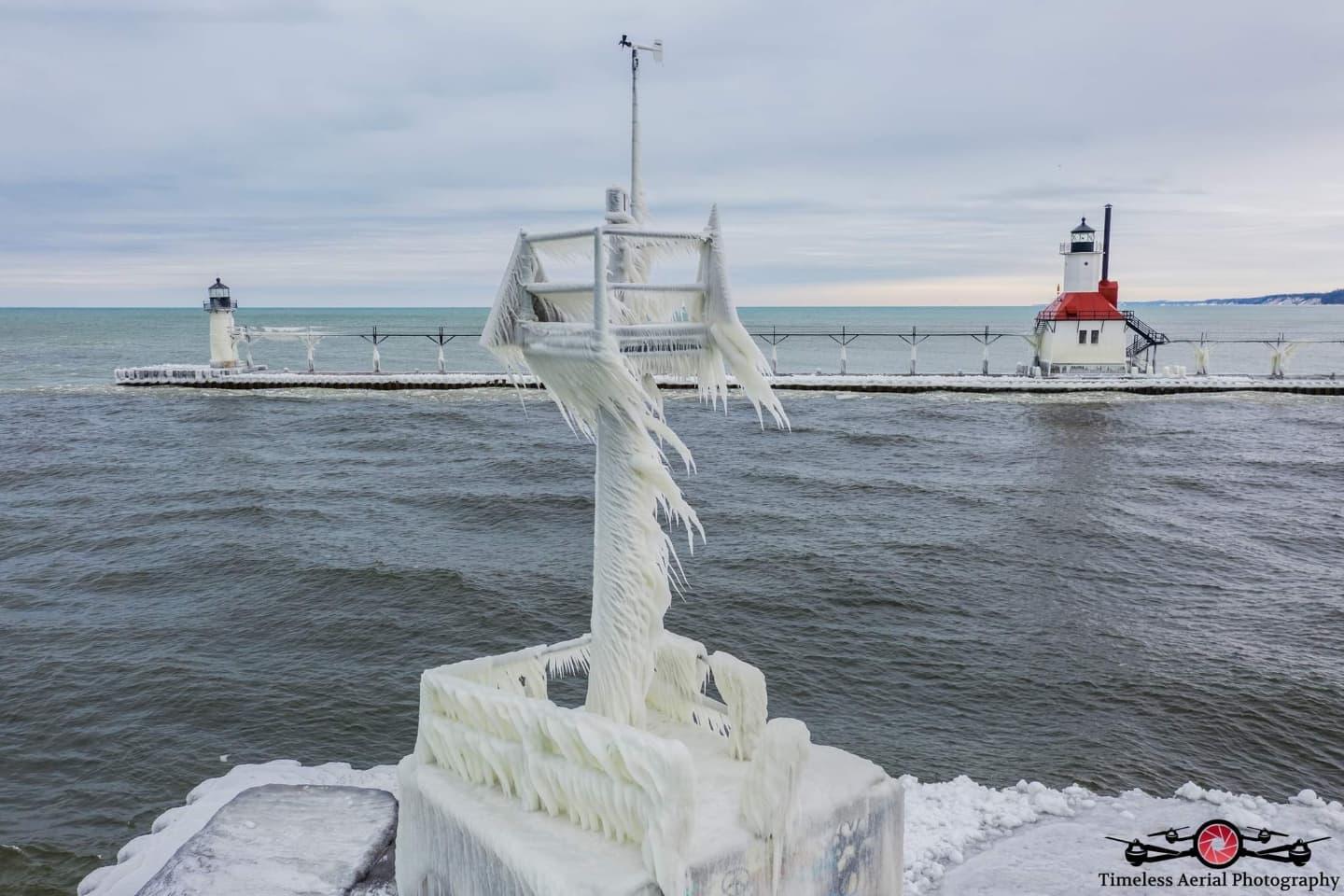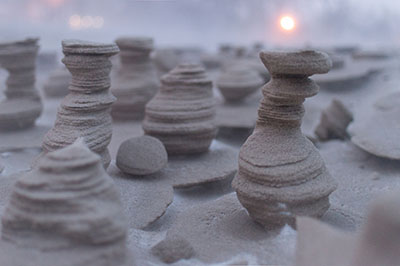Be wowed by Nature

During February, professional ice carvers aren't the only artists that amaze us in Southwest Michigan. Nature does her magic this month (and throughout the late fall and winter) along our Lake Michigan coast. Here are some facts, tips and important cautions that local landscape photographer, Josh Nowicki, shared with us:
What types of ice formations can you see?
Ice formations depend greatly on the progression of the temperatures in late fall and throughout the winter. In Southwest Michigan, it is not unusual to have several thaws and freezes which impact how Nature decorates our shoreline, piers and lighthouses.
Ice balls are usually the first formation you'll see. They start small, roll around in the open water, pick up sand and grow larger as the water and air temperatures drop.
Pancake ice is a circular disk. They form when waves break up the ice sheets, swirling them around and rounding their edges. Their diameters can range from one foot to 10 feet.
An ice shelf is a floating platform of frozen water that forms along the coastline. Even though the ice looks solid, it is not and there are often gaps or weak spots that can cause it to break apart.
Ice mountains form as the ice shelf gets larger and the waves toss water and sand in mounting piles along the shore.
Ice volcanoes are hardened, hollow cones of ice and snow that form on the coast. They look like ordinary hills of ice with a hole in the top, until the waves swell underneath it and erupt through the cone in a "lava" spray of ice and water.
Ice caverns or tubes are rarer occurrences and often can only be seen by boat, kayak or SUP. To form them requires bone-chilling cold temperatures, strong winds and waves to push the piles of ice higher and higher. The waves then carve out crevices or tunnels and the freezing spray turns into beautiful icicle- or stalactite-like formations.
Ribbons of ice form on the lighthouses, piers and catwalk. These are rare occurrences but a photographer's dream when they do happen. Conditions must be just right. The water near the piers and lighthouses must be thawed, temperatures must dip into the teens or single digits and high winds from the northwest or southwest must occur for two to three days. These winds will send large waves crashing and spraying up onto the lighthouses, piers and catwalk to create the frozen, magical, frosting-like scene.
What are sand hoodoos?
 Sand hoodoos are mini-sculptures. They are created when frozen, water-saturated beach sand thaws and then is whipped up by high winds (think 40-50 mph) on a day when temperatures plummet to single digits. It's not an everyday occurrence but it's stunning when it does happen. While hoodoos appear to be spherical, they are not rounded on all sides. The down-wind side is usually more pointed, so keep that in mind when taking photographs of them.
Sand hoodoos are mini-sculptures. They are created when frozen, water-saturated beach sand thaws and then is whipped up by high winds (think 40-50 mph) on a day when temperatures plummet to single digits. It's not an everyday occurrence but it's stunning when it does happen. While hoodoos appear to be spherical, they are not rounded on all sides. The down-wind side is usually more pointed, so keep that in mind when taking photographs of them.
Where are Nature's art "galleries?"
Mountains of ice can be seen all along Lake Michigan's shoreline in Southwest Michigan beginning as early as November. Rare sand hoodoos are more likely to be spotted on wider expanses of sand such as Silver Beach County Park and Tiscornia Park in St. Joseph or Jean Klock Park in Benton Harbor. Those three parks are also good for viewing ice balls, ice pancakes, ice volcanoes and caverns as well as ice ribbons on the lighthouse, piers and catwalk. Other favorite places to see frost and ice creations on shoreline vegetation, driftwood, etc. are Lions Park in St. Joseph and Warren Dunes State Park in Sawyer. Please share your photos on Facebook or Instagram, #swmichigan.
What cautions must you take?
Stay on shore. Ice formations are breathtakingly beautiful but getting close to them can be deadly dangerous. The ice shelves are floating, unstable sheets of frozen water that can easily break and leave you stranded away from shore. Snow often covers the sheets' fissures, cracks and holes that you can suddenly fall through into deep, frigid water. It's also easy for you to be pulled underneath the sheets where you can't be spotted and it's difficult to resurface.
As enticing as it is to go on the piers and out to the lighthouses, stay off them, too. The surface ice on the piers is often crowned or rounded and it's always very slippery. It's difficult to keep your balance, especially on windy days. There's always the danger of sliding over the edge (there's nothing to grab onto) into icy water or onto unstable ice sheets. While we have excellent rescue crews available, it is very difficult to reach you quickly if you are in trouble on the ice or in the water.
Dress warmly from head to toe when walking on the shore or in the dunes. The wind chill temperatures by the Big Lake are colder than in town. The sand on our beaches is also icy, so wear cleats or crampons. Ski poles are helpful, too, for keeping your balance.
Share with Us
Please send us photos and videos of your Southwest Michigan getaway. Use our hashtag #swmichigan or upload your photos to our content collector below. This is an opportunity for your photos to appear on our social media, website or marketing materials. Thanks for sharing your memories!



